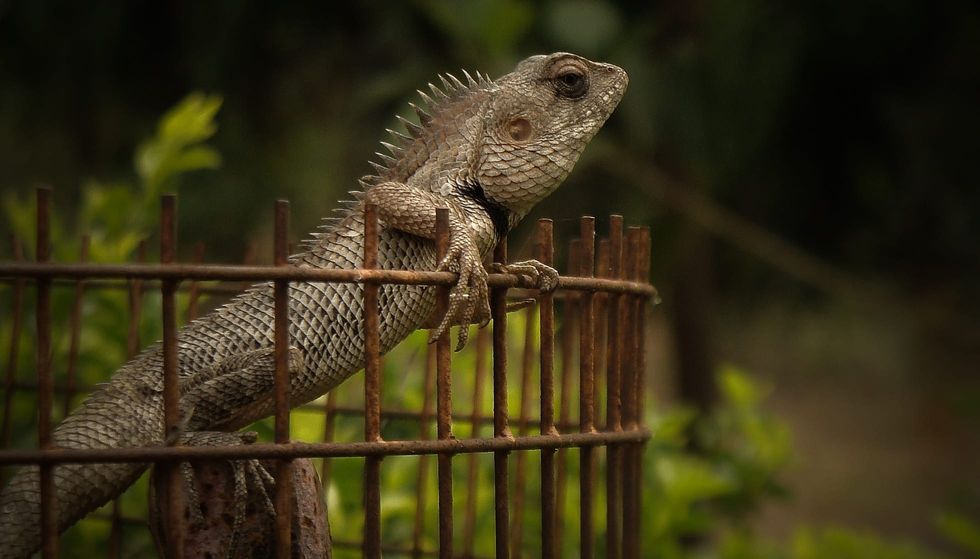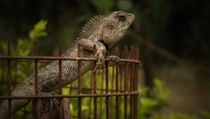Fun Garden Lizard Facts For Kids

Stepping into the garden could lead to a captivating encounter with the elusive garden lizard, a species rich in diversity and known by several names including Calotes versicolor, oriental garden lizard, crested tree lizard, and the Indian garden lizard.
This intriguing reptile is renowned for its remarkable capability to adapt its dietary habits in response to the ecosystem it inhabits.
Particularly during the mating season, these lizards engage in a spectacular transformation, where males showcase luminescent colors with shoulders that blaze in bright orange, and throats that burn a fiery red, signaling their readiness to court.
The garden lizard’s dexterity in avoiding predators is impressive, indicative of their strategic survival tactics which have been honed through evolution. They thrive across a variety of landscapes, from dense forests to the more human-dominated urban gardens, showcasing their unparalleled adaptability within the reptile dominion.
This ability to flourish in diverse environments speaks to the lizard's resiliency and the complexity of its behavioral adaptations. As you explore the existence of this adaptable reptile, you will uncover the intricate aspects of its life cycle, social behavior, and environmental interactions that contribute to the species' overall survival and success in the wild.
Garden Lizard Interesting Facts
What type of animal is a garden lizard?
Garden lizards are reptiles, characterized by their scaly skin and cold-blooded nature.
What class of animal does a garden lizard belong to?
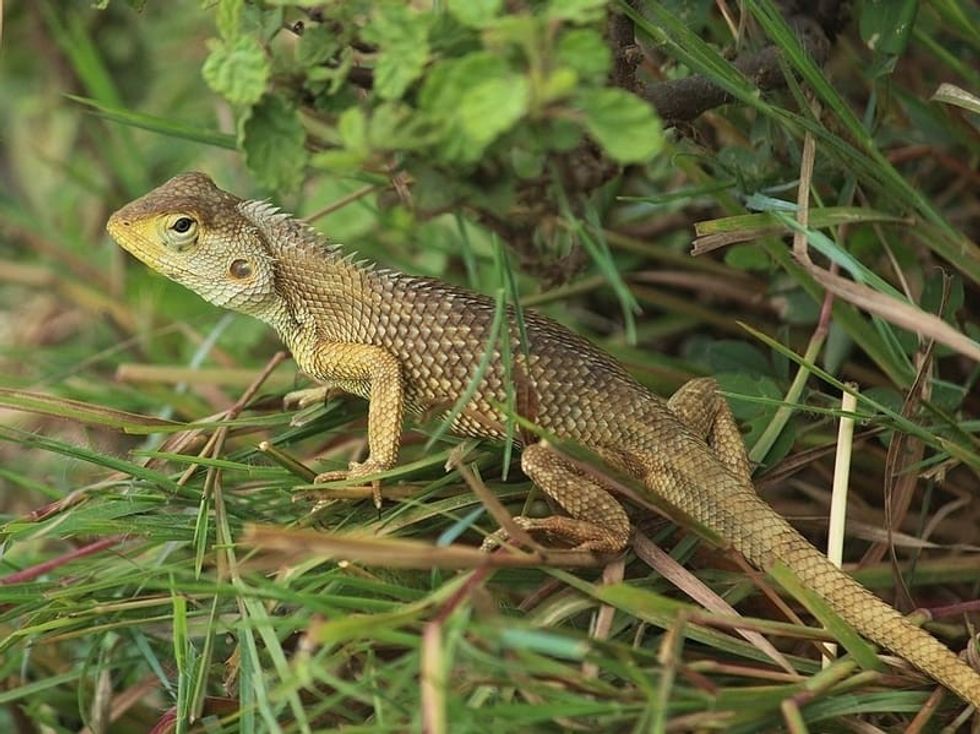
The garden lizard belongs to the class Reptilia, making it a relative to snakes, turtles, and crocodiles.
How many garden lizards are there in the world?
There is no specific count of their population, but they are common in their natural range.
Where does a garden lizard live?
The habitat of the garden lizard is impressively widespread, as they are indigenous to an extensive region, including southeastern Iran, Afghanistan, Bangladesh, Bhutan, Cambodia, India, and Indonesia's Sumatra. These reptiles are also found throughout Malaysia, the Maldives, the Andaman Islands, Mauritius, Myanmar, Nepal, Pakistan, the Philippines, Sri Lanka, Thailand, and Vietnam.
Notably, their adaptability has allowed them to be introduced successfully in additional areas like Brunei, the Seychelles, Singapore, Oman, and even the United States, illustrating their remarkable resilience and capability to thrive in diverse environments.
What is a garden lizard's habitat?
They thrive in a variety of habitats, from forests to urban gardens, trees, shrubs, low vegetation and grasses, displaying versatility in their living conditions.
Who do garden lizards live with?
Usually solitary, these creatures are also occasionally seen basking in groups, especially when there's abundant sunlight.
How long does a garden lizard live?
Their lifespan extends up to 5 years in the wild, varying with environmental conditions and predation.
How do garden lizards reproduce?
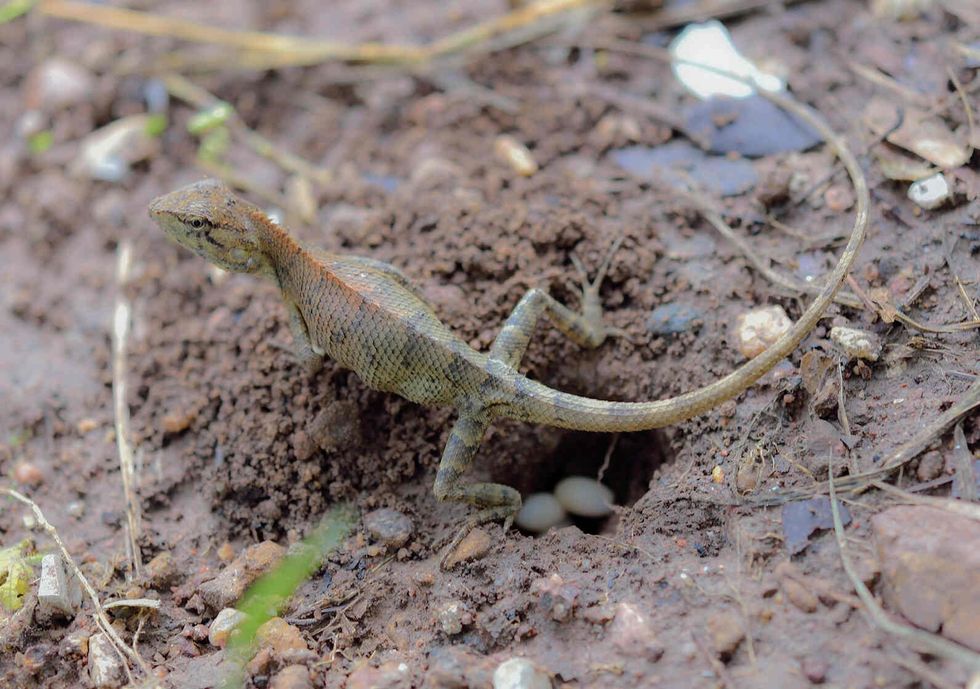
During the breeding season, which peaks around the monsoon, females lay up to sixteen soft oval eggs, often buried near vegetation.
What is the garden lizard's conservation status?
The garden lizard is listed as Least Concern by the International Union for Conservation of Nature (IUCN), indicating its stable presence across its natural habitat range.
Garden Lizard Fun Facts
What do garden lizards look like?
This species showcases a range of colors from grey to brown, with some individuals exhibiting a yellow morph unlike their kind, and generally broad brown bands along the body. Crests and colorful dewlaps add to their allure.
How cute are garden lizards?
With a changeable appearance, their cuteness is subjective, attracting a mix of fascination and admiration.
How do garden lizards communicate?
Visual signals dominate, with physical displays such as dewlap extension being a pivotal aspect of their communication, especially during mating rituals and territorial disputes.
How big is a garden lizard?
This agile creature measures nearly the tail at about 10-16 in (25-40 cm) for adults, suitable for its arboreal lifestyle.
How fast can a garden lizard move?
While exact speed remains speculative, the changeable lizards are quick enough to escape danger and catch prey efficiently.
How much does a garden lizard weigh?
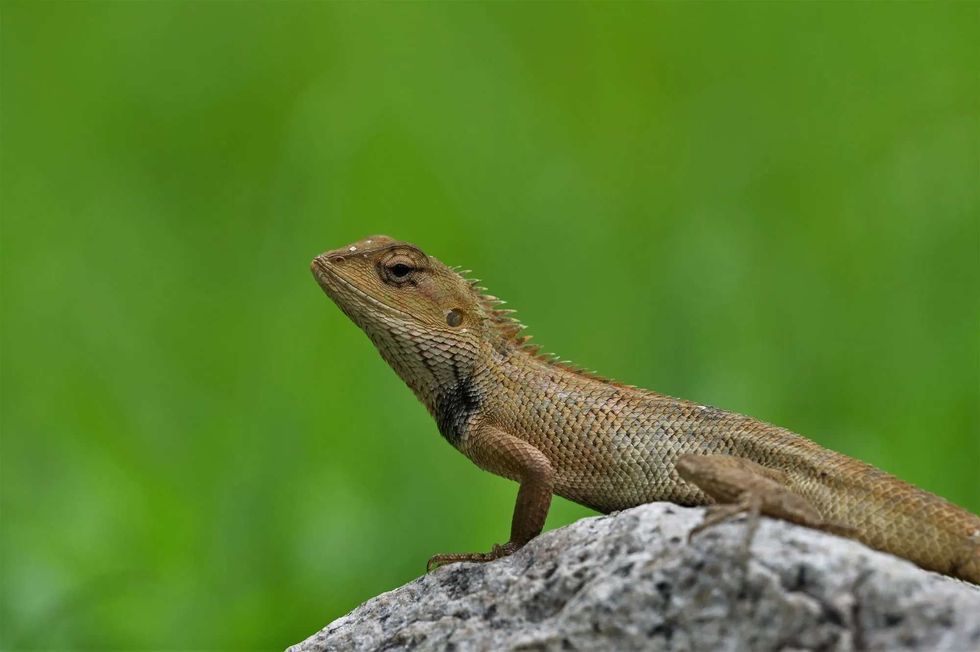
An adult garden lizard can weigh up to 2.5 oz (72 g), aligning with its lithe structure.
What are the male and female names of the garden lizard?
There are no specific terms for male or female garden lizards aside from the generic male lizard and female lizard.
What would you call a baby garden lizard?
A baby is often referred to as a 'hatchling' or 'juvenile', indicating inexperienced status among changeable lizards.
What do garden lizards eat?
The diet of changeable lizards mainly consists of insects, including flies, mealworms, crickets, larvae of hornworms, grasshoppers, earwigs, and grubs, providing them with the necessary proteins for their active lives.
Are garden lizards venomous?
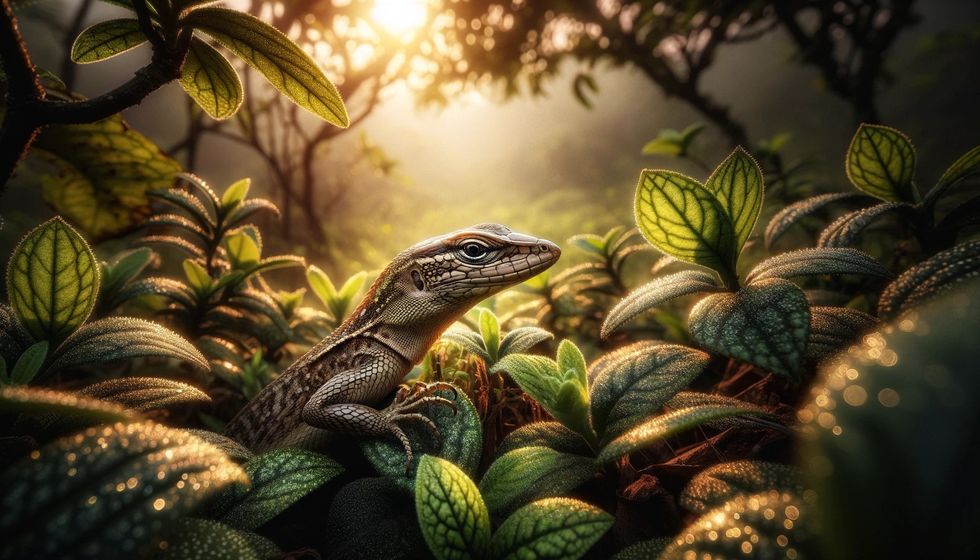
Thankfully, they pose no venomous threat to humans, making encounters with these creatures rather safe.
Would garden lizards make a good pet?
Though some people keep them as pets, their need for a specific set of environmental conditions and diet makes them more suitable for the wild.
Did you know...
The garden lizard, Calotes versicolor, is a master of disguise; its skin may change to match its surroundings, a survival trait that has endeared them to enthusiasts.
During the mating season, the male garden lizard's shoulders turn bright orange, a vivid signal to potential mates and a visible display of their readiness to reproduce. The male's display of his bright red throat is not just for attracting females but also for asserting dominance among rivals.
The diet of changeable lizards, primarily consists of insects, making them a vital part of the ecosystem as natural pest controllers. This dietary preference helps maintain a balance in the garden’s insect population, contributing to the health of both the flora and the fauna.
While the Western fence lizards belong to a different species indigenous to the western United States, garden lizards share the trait of being quite territorial, although they thrive in Southeast Asian gardens. Both species of lizards play significant roles in their respective ecological niches.
Garden lizards exhibit behaviors that set them apart from other lizards, such as their ability to perform push-ups as a form of communication or to signal dominance. These behaviors, coupled with their versatility in habitat choice, allow them to coexist with other lizard species within a shared environment.
Distinctive features of some garden lizard individuals include greyish longitudinal stripes that run along the body, offering camouflage against tree bark and foliage, enhancing their ability to remain unseen by both predators and prey within their natural habitat.
The garden lizard employs vivid color displays and aggressive posturing to discourage intruding males from entering their territory. This visual form of communication is essential for maintaining hierarchy and breeding rights within their populations.
While the primary diet of garden lizards is insectivorous, they have been known to occasionally consume vegetable matter, displaying opportunistic feeding habits that are advantageous in varying environmental conditions.
The common coloration of the garden lizard may range from a light brownish olive to other earth tones, providing them with excellent camouflage against the backdrop of their natural habitat and protecting them from predators. This also allows them to absorb sunlight effectively and maintain their body temperature; a vital aspect of their cold-blooded physiology.
The garden lizard is found widely distributed across Southeast Asia, adaptable to various environments from dense forests to human-inhabited areas, showcasing its impressive ecological versatility.
Among the diverse visual traits of the garden lizard is the presence of a yellowish lateral band that may run along the sides of their body, contributing to their distinctive patterning and aiding in species recognition.
The garden lizard's leathery skin is equipped with scales that serve multiple functions, from aiding in moisture retention to providing a shield against physical abrasions while navigating through their rough arboreal environment.
The garden lizard boasts a dorsal crest that is moderately elevated, running from behind the head down to the tail. This prominent feature is particularly pronounced in males and becomes more noticeable during displays of dominance or courtship.
The belly of a garden lizard is frequently a much lighter color compared to the rest of its body. This coloration is not only a camouflage tactic but also helps reflect excess heat, allowing the lizard to regulate its body temperature more effectively.
While the common garden skink is another reptile often encountered in similar habitats, the garden lizard sets itself apart with its ability to perform dramatic color changes, longer limbs, and a preference for higher perches than its skink cousins.
Some garden lizards exhibit patterns where black streaks radiate from the eyes or extend down the body, providing an additional layer to their complex camouflage tactics that protect them from predators.
Garden lizards have a peculiar food habit where, unlike many other lizard species, they occasionally add plant matter to their predominantly insectivore diet, a trait that has puzzled and intrigued herpetologists.
On a hot sunny day, the garden lizard can often be seen basking in the sunlight. This is crucial for these cold-blooded creatures as the heat from the sun helps them to regulate their body temperature and remain active.
Garden lizards predominantly feast on small insects, which they catch with remarkable precision. Their diet primarily consists of these tiny creatures, which are abundant in their natural habitat, providing a rich source of protein.
The reproductive process of garden lizards involves a period where the female lays eggs, often burying them in soft soil or leaf litter, where they remain until the hatchlings are ready to emerge and fend for themselves.
With agile movements and precise timing, the garden lizard is adept at gripping prey with its jaws. This skill is crucial for their survival, ensuring they efficiently catch the insects upon which they feed.
In India, the garden lizard's tail display is an important part of their mating and territorial behaviors. A raised tail can signal various intentions, from courting a potential mate to asserting dominance over a particular area.
The natural history of the garden lizard is rich and varied, considering their widespread distribution and adaptability to different environmental conditions. Studies of their behavior, diet, and reproduction provide insights into their ecological role and evolutionary adaptations.
The inexperienced changeable lizards often display more subdued coloration compared to adults, which can serve as an adaptive tactic to remain inconspicuous while learning to navigate its environment.
FAQs About Garden Lizards
What type of garden lizard is that little reptile in your yard?
The small lizards commonly found in gardens are typically species like the garden/changeable lizard (Calotes versicolor), also known as oriental garden lizards, or depending on your location, other native lizard species such as anoles, geckos, or skinks. These creatures are advantageous to have around as they often feed on insects, helping to control pest populations naturally.
Can you have a garden lizard as a pet?
While it is possible to keep a garden lizard, such as Calotes versicolor, as a pet, it requires a specific commitment to their care, replicating their natural habitat conditions, diet of insects, and providing adequate space and environmental stimulation. It is essential to research the needs of the species thoroughly and ensure compliance with local wildlife regulations.
What are garden lizards good for?
Garden lizards offer natural pest control as they primarily consume insects, which can help maintain a balanced ecosystem in your garden. They are a crucial component of the garden's biodiversity and help to reduce the population of insects that might otherwise damage plants and crops.
Is garden lizard and chameleon same?
No, garden lizards and chameleons are not the same. The name 'garden lizard' often refers to species such as the Calotes versicolor, which can change color but not as dramatically or extensively as chameleons. Chameleons belong to a distinct family, Chamaeleonidae, known for their highly specialized color-changing abilities, long tongues, and unique eye movements, distinguishing them from garden lizards.
From the bushes of oriental garden to the branches of suburban trees, the garden lizard, or Calotes versicolor, is a captivating subject of the reptile kingdom. Its diet flexibility, notable breeding season displays, and the ways in which changeable lizards escape danger all contribute to this species' resilience and adaptability.
Whether they're showcasing bright orange shoulders or a calm brown hue, these creatures continue to intrigue and delight observers with their sheer presence and survival strategies.
We Want Your Photos!
More for You
Sources
https://en.wikipedia.org/wiki/Oriental_garden_lizard
https://baliwildlife.com/encyclopedia/animals/reptiles/agamid-lizards/common-garden-lizard/
https://vocal.media/futurism/oriental-garden-lizard
https://www.wikidata.org/wiki/Q41489
https://en.wikipedia.org/wiki/Calotes
https://animaldiversity.org/accounts/Calotes_versicolor/classification/
https://animalia.bio/oriental-garden-lizard
https://a-z-animals.com/blog/why-do-lizards-do-push-ups/
https://www.reptileknowledge.com/reptile-pedia/why-do-lizards-in-arizona-do-push-ups
Bachelor of Science specializing in Mass Communication.

Adekunle Olanrewaju JasonBachelor of Science specializing in Mass Communication.
Bachelor of Arts specializing in English and Drama, Master of Arts specializing in Performance: Design and Practice

Luca DemetriouBachelor of Arts specializing in English and Drama, Master of Arts specializing in Performance: Design and Practice
Experienced in writing and sub-editing, Luca holds a Bachelor's in English Literature and Drama from the University of Birmingham, where he served as the culture editor at Redbrick Paper. He is currently pursuing a Master's in Performance: Design and Practice at the University of the Arts in London, showcasing his passion for the arts, performance, and history. With a keen interest in traveling, Luca enjoys exploring new cultures and experiencing diverse perspectives.
Disclaimer
1) Kidadl is independent and to make our service free to you the reader we are supported by advertising. We hope you love our recommendations for products and services! What we suggest is selected independently by the Kidadl team. If you purchase using the Buy Now button we may earn a small commission. This does not influence our choices. Prices are correct and items are available at the time the article was published but we cannot guarantee that on the time of reading. Please note that Kidadl is a participant in the Amazon Services LLC Associates Program, an affiliate advertising program designed to provide a means for sites to earn advertising fees by advertising and linking to Amazon. We also link to other websites, but are not responsible for their content.
2) At Kidadl, we strive to recommend the very best activities and events. We will always aim to give you accurate information at the date of publication - however, information does change, so it’s important you do your own research, double-check and make the decision that is right for your family. We recognise that not all activities and ideas are appropriate for all children and families or in all circumstances. Our recommended activities are based on age but these are a guide. We recommend that these ideas are used as inspiration, that ideas are undertaken with appropriate adult supervision, and that each adult uses their own discretion and knowledge of their children to consider the safety and suitability. Kidadl cannot accept liability for the execution of these ideas, and parental supervision is advised at all times, as safety is paramount. Anyone using the information provided by Kidadl does so at their own risk and we can not accept liability if things go wrong.
3) Because we are an educational resource, we have quotes and facts about a range of historical and modern figures. We do not endorse the actions of or rhetoric of all the people included in these collections, but we think they are important for growing minds to learn about under the guidance of parents or guardians.

